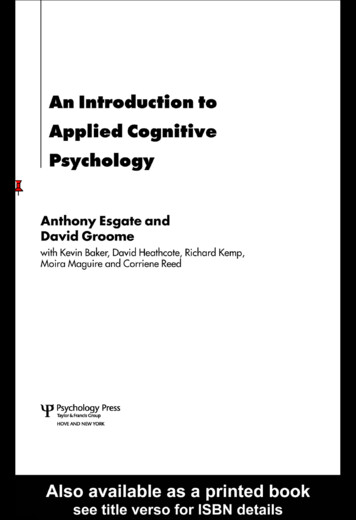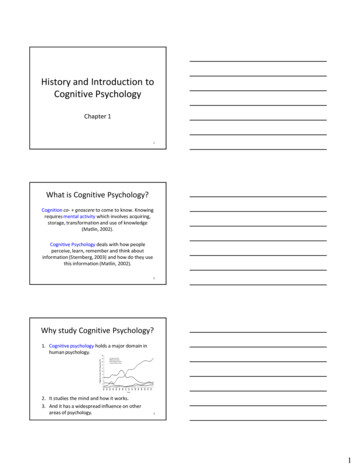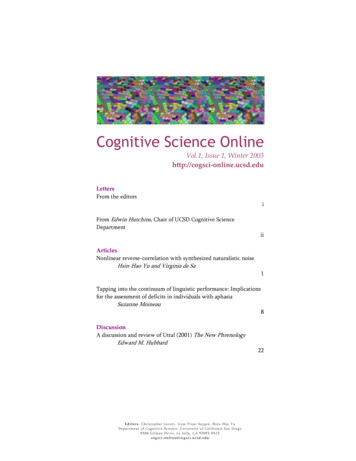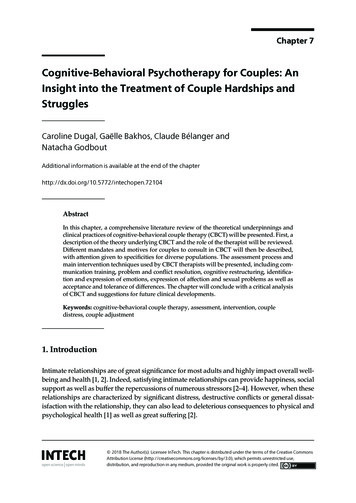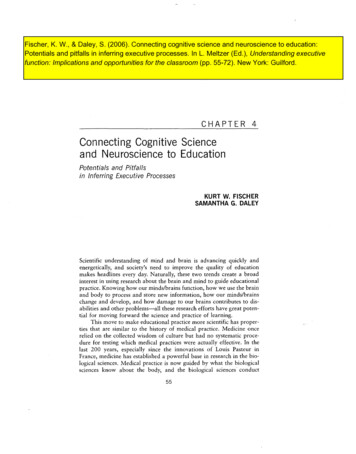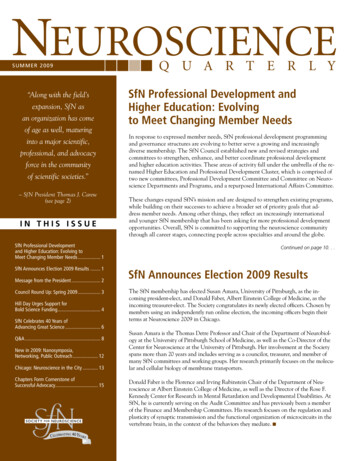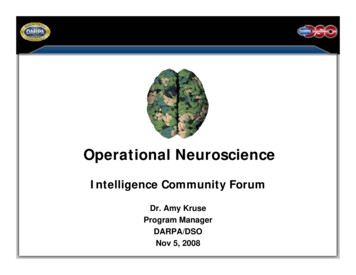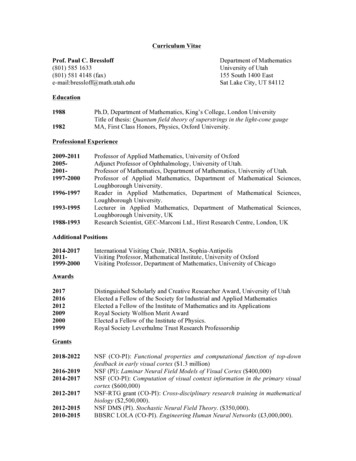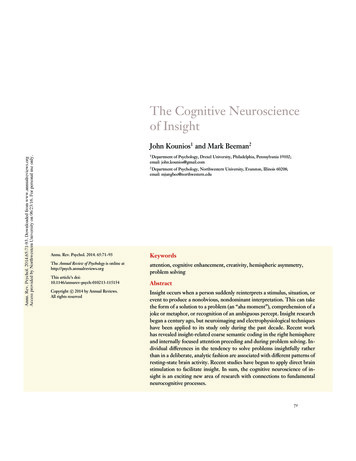
Transcription
PS65CH04-KouniosARIANNUALREVIEWS31 October 20139:37FurtherAnnu. Rev. Psychol. 2014.65:71-93. Downloaded from www.annualreviews.orgAccess provided by Northwestern University on 06/23/16. For personal use only.Click here for quick links toAnnual Reviews content online,including: Other articles in this volume Top cited articles Top downloaded articles Our comprehensive searchThe Cognitive Neuroscienceof InsightJohn Kounios1 and Mark Beeman21Department of Psychology, Drexel University, Philadelphia, Pennsylvania 19102;email: john.kounios@gmail.com2Department of Psychology, Northwestern University, Evanston, Illinois 60208;email: mjungbee@northwestern.eduAnnu. Rev. Psychol. 2014. 65:71–93KeywordsThe Annual Review of Psychology is online athttp://psych.annualreviews.orgattention, cognitive enhancement, creativity, hemispheric asymmetry,problem solvingThis article’s doi:10.1146/annurev-psych-010213-115154c 2014 by Annual Reviews.Copyright ⃝All rights reservedAbstractInsight occurs when a person suddenly reinterprets a stimulus, situation, orevent to produce a nonobvious, nondominant interpretation. This can takethe form of a solution to a problem (an “aha moment”), comprehension of ajoke or metaphor, or recognition of an ambiguous percept. Insight researchbegan a century ago, but neuroimaging and electrophysiological techniqueshave been applied to its study only during the past decade. Recent workhas revealed insight-related coarse semantic coding in the right hemisphereand internally focused attention preceding and during problem solving. Individual differences in the tendency to solve problems insightfully ratherthan in a deliberate, analytic fashion are associated with different patterns ofresting-state brain activity. Recent studies have begun to apply direct brainstimulation to facilitate insight. In sum, the cognitive neuroscience of insight is an exciting new area of research with connections to fundamentalneurocognitive processes.71
PS65CH04-KouniosARI31 October 20139:37ContentsAnnu. Rev. Psychol. 2014.65:71-93. Downloaded from www.annualreviews.orgAccess provided by Northwestern University on 06/23/16. For personal use only.INTRODUCTION . . . . . . . . . . . . . . . . . . . . . . . . . . . . . . . . . . . . . . . . . . . . . . . . . . . . . . . . . . . . . . .WHAT IS INSIGHT? . . . . . . . . . . . . . . . . . . . . . . . . . . . . . . . . . . . . . . . . . . . . . . . . . . . . . . . . . . . .SCOPE OF THE REVIEW . . . . . . . . . . . . . . . . . . . . . . . . . . . . . . . . . . . . . . . . . . . . . . . . . . . . . . .COGNITIVE PSYCHOLOGY OF INSIGHT . . . . . . . . . . . . . . . . . . . . . . . . . . . . . . . . . . . .NEURAL BASIS OF INSIGHT . . . . . . . . . . . . . . . . . . . . . . . . . . . . . . . . . . . . . . . . . . . . . . . . . . .Hemispheric Asymmetry . . . . . . . . . . . . . . . . . . . . . . . . . . . . . . . . . . . . . . . . . . . . . . . . . . . . . . . .Neural Correlates of Insight Solving . . . . . . . . . . . . . . . . . . . . . . . . . . . . . . . . . . . . . . . . . . . . .Preparation for Insight . . . . . . . . . . . . . . . . . . . . . . . . . . . . . . . . . . . . . . . . . . . . . . . . . . . . . . . . . .Resting-State Brain Activity and Individual Differences . . . . . . . . . . . . . . . . . . . . . . . . . . .ATTENDING IN, OUT, AND AROUND . . . . . . . . . . . . . . . . . . . . . . . . . . . . . . . . . . . . . . . .FACTORS THAT INFLUENCE THE LIKELIHOOD OF INSIGHT . . . . . . . . . . . .Mood . . . . . . . . . . . . . . . . . . . . . . . . . . . . . . . . . . . . . . . . . . . . . . . . . . . . . . . . . . . . . . . . . . . . . . . . . .Mood and Attention . . . . . . . . . . . . . . . . . . . . . . . . . . . . . . . . . . . . . . . . . . . . . . . . . . . . . . . . . . . .Models of Attention . . . . . . . . . . . . . . . . . . . . . . . . . . . . . . . . . . . . . . . . . . . . . . . . . . . . . . . . . . . .Cognitive Control . . . . . . . . . . . . . . . . . . . . . . . . . . . . . . . . . . . . . . . . . . . . . . . . . . . . . . . . . . . . . .STIMULATING INSIGHT . . . . . . . . . . . . . . . . . . . . . . . . . . . . . . . . . . . . . . . . . . . . . . . . . . . . . .FUTURE DIRECTIONS . . . . . . . . . . . . . . . . . . . . . . . . . . . . . . . . . . . . . . . . . . . . . . . . . . . . . . . . .7273747577777880818283838485858687INTRODUCTIONIn an article in the Annual Review of Astronomy and Astrophysics, William Wilson Morgan (1988)summarized several of the groundbreaking scientific contributions he made over his long career.One of these was the discovery of the structure of the Milky Way galaxy. What isn’t obvious fromhis article is how he came to make this discovery (Sheehan 2008).In 1951, Morgan had been calculating the distances of OB associations, which are groups of hot,bright stars. OB associations are considered “star nurseries” because these stars are young. Oneevening, he finished his work for the night and started to walk home from the Yerkes Observatory.He glanced up at the sky to observe the stars that he had been studying and had what he called a“flash inspiration . . . a creative intuitional burst”: These stars are organized in a three-dimensional,strand-like structure. Galaxies come in a variety of forms, but he knew that in spiral galaxies OBassociations reside in the galactic arms. Morgan understood that the strand-like form was a galacticarm and that he had directly apprehended the spiral structure of the Milky Way, a realization thathe substantiated with data that he presented at a conference a few months later.Morgan’s breakthrough realization was an insight, colloquially known as an “aha moment”—asudden, conscious change in a person’s representation of a stimulus, situation, event, or problem(Kaplan & Simon 1990). Awareness of this kind of representational change, though abrupt, takesplace after a period of unconscious processing (van Steenburgh et al. 2012). Because insights arelargely a product of unconscious processing, when they emerge, they seem to be disconnectedfrom the ongoing stream of conscious thought. In contrast, analytic thought is deliberate andconscious and is characterized by incremental awareness of a solution (Smith & Kounios 1996).Although Morgan’s insight was literally on a cosmic scale, the phenomenon of insight, in amore modest guise, is a common experience that occurs in perception, language comprehension,problem solving, and other domains of cognition (van Steenburgh et al. 2012). It is therefore ofinterest to ask what happened in Morgan’s brain and in the brains of many other people when theyhave had an insight. This article reviews relevant cognitive neuroscience research and an emerging72Kounios·Beeman
PS65CH04-KouniosARI31 October 20139:37theoretical framework that is progressing toward an answer to this question. Before describingthis work, we circumscribe the insight phenomenon to specify the domain of this review.Annu. Rev. Psychol. 2014.65:71-93. Downloaded from www.annualreviews.orgAccess provided by Northwestern University on 06/23/16. For personal use only.WHAT IS INSIGHT?Insight is often defined as a sudden change in or the formation of a concept or other type ofknowledge representation, often leading to the solution of a problem. These changes are thoughtto have certain attributes. For example, insights are frequently accompanied by a burst of emotion,including a highly positive surprise at either the content or manner of the realization. In contrast,analytic solutions are not typically accompanied by an emotional response except perhaps for asense of satisfaction resulting from completing the task. However, though not an unusual concomitant, a conscious emotional response is not a necessary feature of insight. Participants in manystudies have solved dozens of verbal puzzles with insight (e.g., Jung-Beeman et al. 2004, Smith &Kounios 1996) without reports of multiple bursts of emotion.Another feature is that insights often break an impasse or mental block produced because asolver initially fixated on an incorrect solution strategy or strong but ultimately unhelpful associations of a problem. The breaking of an impasse is accompanied by the reinterpretation orrestructuring of a problem to reveal a new, often simple, solution or solution strategy. Some researchers implicitly consider problem restructuring and the breaking of an impasse to be definingfeatures of insight (e.g., Cranford & Moss 2012). However, this view excludes prominent types ofinsights, such as those that occur (a) when the solution suddenly intrudes on a person’s awarenesswhen he or she is not focusing on any solution strategy, (b) when an insight pointing to a solutionoccurs while a person is actively engaged in analytic processing but has not yet reached an impasse,and (c) when a person has a spontaneous realization that does not relate to any explicitly posedproblem. We therefore do not consider the breaking of an impasse to be a precondition for insight.Thus, there are a number of potential definitions of insight, depending on which combinationof features one selects. Very narrowly defined, insight could be thought of as a sudden solution to aproblem preceded by an impasse and problem restructuring and followed by a positive emotionalresponse. In contrast, the broadest definition of insight is the common nonscientific one in which aninsight is any deep realization, whether sudden or not. Within cognitive psychology and cognitiveneuroscience, inconsistency exists concerning what we consider to be a basic criterion for insight,namely, suddenness. For example, a number of purported insight studies do not specifically isolateand focus on solutions that occurred suddenly (e.g., Luo & Niki 2003, Wagner et al. 2004).Another broad use of the term insight can be found in clinical psychology, in which insightrefers to self-awareness, often of one’s own symptoms, functional deficits, or other kind of predicament. The clinical and nonscientific uses of the term do not require suddenness of realization orany accompanying emotional response. Indeed, in clinical psychology, the lack of an emotionalresponse could itself be considered a symptom signifying a lack of insight.The issue of defining insight is not an exercise in pedantry. When insight is defined too broadly,it includes so many diverse, loosely related phenomena that it becomes virtually impossible forresearchers to draw general conclusions. For example, one recent review of cognitive neuroscienceresearch on creativity and insight lumps together widely diverse studies characterized by a variety ofdefinitions, assumptions, experimental paradigms, empirical phenomena, analytical methods, andstages of the solving process (and inconsistent experimental rigor). Unsurprisingly, because of suchindiscriminate agglomeration, that review failed to find much consistency across studies, leadingthe authors to pronounce a negative verdict on the field (Dietrich & Kanso 2010). In contrast,going to the other extreme by adopting an overly narrow definition of insight can lead one to missimportant large-scale generalizations that cut across particular experimental paradigms.www.annualreviews.org The Cognitive Neuroscience of Insight73
ARI31 October 20139:37Thus, progress in studying insight can be facilitated or enhanced by “carving nature at its joints”and adopting a middle-path definition of insight to guide the selection of empirical phenomenaand the development of experimental paradigms for its study. Specifically, we define insight asany sudden comprehension, realization, or problem solution that involves a reorganization ofthe elements of a person’s mental representation of a stimulus, situation, or event to yield anonobvious or nondominant interpretation. Insights are not confined to any particular domain ofunderstanding, but we do not include all sudden realizations within this definition. For example,the reading of an isolated word starts with unconscious processing followed by a sudden consciousrealization of the word’s meaning. But this is not an insight, because it doesn’t involve reorganizinga mental representation to arrive at a nonobvious or nondominant interpretation. Insights maybe especially salient when they follow an impasse, but impasse is not a necessary preconditionfor insight; otherwise, spontaneous sudden realizations would be excluded because they are notassociated with an explicit problem whose solution is blocked by another idea. Insights are oftenaccompanied by surprise and a positive burst of conscious emotion, but we do not consider theseto be defining features because individual insights in a sequence of insights, as occur in manyexperimental studies, don’t all elicit such conscious affective responses. (Of course, this doesn’texclude the possibility that all insights may be accompanied by unconscious affective responses;cf. Topolinski & Reber 2010.) Phenomena such as impasse and emotion play important rolesin problem solving and are worthy of study. However, isolating the core processes of insightis a prerequisite for investigating it. To accomplish this, we adopt a “Goldilocks” approach—neither too much nor too little—and argue that this strategy can, and has, enabled progress inunderstanding insight’s neurocognitive substrates.It is also critical to recognize that insight involves several component processes working together and unfolding over time. Experimental paradigms that emphasize one process over anotherwill reveal different parts of this network. Such results may appear complex but actually paint aricher picture of insight, just as studying encoding and retrieval, or implicit and explicit learning,paints a more complete picture of how the brain supports memory.Annu. Rev. Psychol. 2014.65:71-93. Downloaded from www.annualreviews.orgAccess provided by Northwestern University on 06/23/16. For personal use only.PS65CH04-KouniosSCOPE OF THE REVIEWThis review discusses the current state of cognitive neuroscience research on insight. Thoughwe also discuss selected behavioral cognitive studies that inform the neuroscientific frameworkwe describe, we do not provide an overall review of the relevant cognitive literature here. Recent reviews of the cognitive literature are available elsewhere (e.g., van Steenburgh et al. 2012).Moreover, our discussion of neuroscientific studies is not exhaustive. We focus on those that meetseveral methodological criteria.The first desideratum is that a study must demonstrably isolate the insight phenomenon. Somestudies present problems to participants and simply assume that the solutions are the result ofinsight rather than analytical thought. However, as described below, many types of problems canbe solved by either insight or analysis (Bowden et al. 2005). Therefore, with some exceptions,we do not discuss studies that do not demonstrate that participants’ solutions were, in fact, aproduct of insight. One exception to this criterion is studies that use classic insight problems, suchas the Nine-Dot Problem, that have been used by researchers for many decades and for whicha consensus has been tacitly reached—though perhaps not yet with sufficient justification—thatsolutions to these problems are usually achieved by insight (e.g., Chi & Snyder 2012).A number of studies examine brain activity when people recognize rather than generate solutions (e.g., Ludmer et al. 2011, Luo et al. 2011, Metuki et al. 2012). People may feel a senseof insight upon recognizing solutions, but these postsolution recognition processes differ from74Kounios·Beeman
Annu. Rev. Psychol. 2014.65:71-93. Downloaded from www.annualreviews.orgAccess provided by Northwestern University on 06/23/16. For personal use only.PS65CH04-KouniosARI31 October 20139:37the processes responsible for generating the solutions. Once people see a solution word, they canperform a directed semantic memory search to connect the solution to the problem rather than anopen-ended search for associations that might lead to the solution. Although solution recognitionis itself interesting, it differs from pure insight.A second criterion is that a candidate study must use an appropriate control or comparisoncondition. For example, in studies that use remote associates problems or anagrams, insight solutions can be directly compared to analytic solutions for the same type of problem because thiscomparison controls for all factors except for the cognitive solving strategy—insight versus analytic processing—that is the factor of primary interest. We therefore do not focus on studies thatdirectly compare neural activity for sets of problems that differ in complexity, solving duration,visual content, working-memory load, and so forth (e.g., Aziz-Zadeh et al. 2013, Sheth et al. 2008)because differences in cognitive strategy are confounded with these ancillary factors. We wish tohighlight how insight solving differs from analytic solving when other factors are held relativelyconstant.Other studies are not discussed here due to methodological issues that cannot be addressedon a study-by-study basis in an article of this scope, such as problematic baselining of neuralactivity (e.g., Sandkühler & Bhattacharya 2008). Another type of methodological issue involvesthe integration over time of functional magnetic resonance imaging (fMRI) signal. One studyattempted to use both subjective (self-report) and objective measures to distinguish insight fromanalytic solving (Aziz-Zadeh et al. 2009). Unfortunately, the objective measure was speed ofsolution: It was assumed that fast solutions were achieved with insight and slow solutions wereachieved analytically. Not only is this assumption questionable, it also completely confounds theexperimental contrast with the duration of solving effort. Because fMRI signal is integrated overtime—the longer an area is active, the more the measured signal will increase—it is very sensitiveto such confounds. Thus, it is impossible to know which effects were real and which were confoundrelated.It is important to note that the studies that are not discussed here due to methodological issuesare not entirely uninformative. However, careful consideration must be given to each of theseissues in the context of interpreting the results.COGNITIVE PSYCHOLOGY OF INSIGHTMuch of the cognitive psychology research on insight done over the past three decades aimedto clarify the relationship between insightful and analytic thought (Sternberg & Davidson 1995).Early gestalt studies distinguished insight and analysis almost solely on the basis of the informalconscious experience of a problem solution emerging suddenly versus gradually. To extend thisresearch, cognitive psychologists attempted to uncover more formal evidence to distinguish thesetwo types of processing. A prominent example is a pioneering series of studies done by JanetMetcalfe during the 1980s. For example, Metcalfe & Wiebe (1987) focused on metacognitivecharacteristics of insight such as participants’ feelings of “warmth” (i.e., closeness to solution) whileworking on insight and analytic problems. Participants reported a gradual increase in feelings ofwarmth leading up to analytic solutions, but little or no warmth preceding insights until shortlybefore they solved the problem. Moreover, insight problems that were accompanied by feelingsof warmth usually elicited incorrect solutions.Metcalfe & Wiebe’s (1987) study was groundbreaking in showing a behavioral difference between insight and analytic solving beyond factors that differentially affected solution rates forthese two types of problems. However, because Metcalfe’s study sampled participants’ feelingsonly once every 15 seconds, it did not directly address one of the central characteristics thoughtwww.annualreviews.org The Cognitive Neuroscience of Insight75
ARI31 October 20139:37to distinguish insight and analytic solving, namely, the suddenness of solution. Rather, her procedure was designed to examine changes over time in participants’ feelings about their closenessto solution.However, it is possible to measure the accrual of solution information with higher temporalresolution using the speed-accuracy decomposition procedure (Kounios et al. 1987, Meyer et al.1988). This technique revealed no discernable partial response information preceding the solutionwhen people solve insight-like anagrams (Smith & Kounios 1996). Thus, insight solving occursin a discrete transition from a state of no conscious information about the solution to the finalcomplete solution, with no intermediate states. In contrast, for similar speed-accuracy decomposition studies of other (noninsight) tasks, such as lexical decision, semantic verification, short-termrecognition memory, and long-term recognition memory, people show evidence of substantialpartial information (Smith & Kounios 1996). This finding objectively validated the consciousexperience of the abruptness of insight.The conscious experience of insight directly relates to unconscious processing that precedes it.When people solve problems (anagrams), they solve better and experience their solutions as moreinsight-like when, prior to solution, solution-related words are presented to them subliminally(Bowden 1997). The fact that a subliminal prime can spark a later insight supports the hypothesisthat insight solutions are preceded by substantial unconscious processing rather than spontaneously generated. Similarly, when people respond to solution words before solving a problem,the amount of semantic priming for solution words—an index of related unconscious processing—is directly related to how they experience the recognition of the solution. Specifically, people showmore solution priming when they recognize solution words with a feeling of sudden insight thanwhen they recognize the words without an insight experience (Bowden & Jung-Beeman 2003b).These studies are also notable for a methodological innovation. Much of the insight literaturecompares performance on so-called insight problems with performance on analytic problems, adistinction based largely on researchers’ intuitions or introspections about sudden versus gradual solution. This phenomenological difference had rarely been measured and quantified in arigorous way. Furthermore, applying the monikers “insight” and “analytic” to specific problemsassumes that all participants will always solve insight problems insightfully and analytic problemsanalytically—hardly a safe assumption. To put insight research on a firmer empirical foundation, Bowden (1997) developed a procedure for soliciting participants’ trial-by-trial judgments ofwhether a solution had been derived by insight or analysis. This technique has been validated bysubsequent studies that have shown that the number of insight solutions and analytic solutionsto a series of problems varies independently as a function of factors such as mood (Subramaniamet al. 2009) and meaningfully with respect to cognitive strategies (Kounios et al. 2008) and brainactivations ( Jung-Beeman et al. 2004, Kounios et al. 2006, Subramaniam et al. 2009). The insightjudgment procedure has thus provided a foundation for subsequent neuroimaging studies of insight because it allows researchers to isolate the insight phenomenon by controlling for ancillarydifferences between problems that were solved insightfully and analytically (Bowden et al. 2005,Kounios & Beeman 2009).The development of short problems solvable by insight (Bowden & Jung-Beeman 2003a) hasalso proved useful in later neuroscience studies. Early studies of insight typically posed a smallnumber of complex problems to participants. Most participants take many minutes to solve suchproblems, when they are able to solve them. However, neuroimaging and electrophysiologicalmethods require many trials to accurately record brain activity. An alternative approach uses arelatively large number of structurally identical verbal problems, called remote associates problems, modeled after one type of problem developed by Mednick for his remote associates test ofcreativity (Mednick 1962). Bowden & Jung-Beeman (2003a) developed a set of compound remoteAnnu. Rev. Psychol. 2014.65:71-93. Downloaded from www.annualreviews.orgAccess provided by Northwestern University on 06/23/16. For personal use only.PS65CH04-Kounios76Kounios·Beeman
PS65CH04-KouniosARI31 October 20139:37associates problems that consist of three words (e.g., pine, crab, sauce). The participant’s task isto think of a single solution word (apple) that will form a compound or familiar phrase with eachof the three problem words (pineapple, crabapple, applesauce).Remote associates problems are well suited to neuroimaging and electrophysiological studies.Large numbers of these problems have been developed, allowing for neuroimaging and electrophysiological studies with a sufficient number of trials per condition. Other types of shortproblems can serve this function as well. For example, anagrams have also been used with theinsight judgment procedure (Bowden 1997, Kounios et al. 2008).NEURAL BASIS OF INSIGHTAnnu. Rev. Psychol. 2014.65:71-93. Downloaded from www.annualreviews.orgAccess provided by Northwestern University on 06/23/16. For personal use only.Hemispheric AsymmetryMuch of the research on the neural basis of insight has been framed by hemispheric differences,namely, that the right hemisphere contributes relatively more to insight solving than to analyticsolving, whereas the left hemisphere contributes more to analytic solving than to insight solving.This hypothesis particularly influenced the experimental methods and predictions of early cognitive neuroscience studies of insight. For instance, several studies used visually lateralized probewords to detect and compare semantic processing in the hemispheres while participants workedon remote associates problems. On trials for which participants failed to solve problems within atime limit, they still showed semantic priming for the solution words by responding to solutionword probes more quickly than to unrelated word probes. Importantly, this solution priming wasespecially pronounced when the solution word probes were presented to the left visual field, thusbeing directed initially to the right hemisphere (Beeman & Bowden 2000, Bowden & Beeman1998). Furthermore, enhanced priming in the right hemisphere occurred only when participantsreported that they recognized a solution word probe with a feeling of insight (Bowden & JungBeeman 2003b).This rightward asymmetry of insight processing was predicted (Bowden & Beeman 1998) on thebasis of prior evidence of right hemisphere involvement in integrating distant semantic relationsin language input (e.g., St George et al. 1999) as well as a theoretical framework that describesthe right hemisphere as engaging in relatively coarser semantic coding than the left hemisphere( Jung-Beeman 2005). This framework incorporates neuropsychological and neurological evidenceof subtle comprehension deficits following right hemisphere brain damage with neuroanatomicalfindings of asymmetric neuronal wiring.According to the coarse semantic coding framework, when readers or listeners encounter a wordor concept, they activate a semantic field related to the word: a subset of features, properties, andassociations of that word. Evidence suggests that the left hemisphere strongly activates a relativelysmaller semantic field of features, those most closely related to the dominant interpretation or thecurrent context; in contrast, the right hemisphere weakly activates a relatively broader semanticfield, including features that are distantly related to the word or context (Chiarello 1988, Chiarelloet al. 1990). Despite some obvious limitations, coarser semantic coding in the right hemispherehas one big advantage: The less sharply each word’s meaning is specified, the more likely it isto connect to other words and concepts. This is a key ingredient for drawing inferences (Virtueet al. 2006, 2008), extracting the gist (St George et al. 1999), comprehending figurative language(Mashal et al. 2008), and for insight.The coarse semantic coding notion is more than a metaphor. Rather, it potentially links asymmetric semantic processing to asymmetric brain wiring. Aside from some size asymmetries in particular regions of cortex (such as Broca’s area and Wernicke’s area), lateralized cytoarchitectonicwww.annualreviews.org The Cognitive Neuroscience of Insight77
ARI31 October 20139:37differences also influence how neurons integrate inputs (for a review, see Hutsler & Galuske 2003).In brief, pyramidal neurons collect inputs through their dendrites. Differences in synaptic distributions along dendrites influence the type of inputs that cause these pyramidal neurons to fire. Therange of cortical area over which neurons collect inputs could be termed their input fields. In association cortices in or near language-critical areas, such as Wernicke’s area, Broca’s area, and theanterior temporal cortex, right hemisphere neurons have larger input fields than do left hemisphereneurons (e.g., Jacob et al. 1993, Scheibel et al. 1985, Seldon 1981). Specifically, right hemispherepyramidal neurons have more synapses overall and especially more synapses far from the cell body.This indicates that they have larger input fields than corresponding left hemisphere pyramidalneurons. Because cortical connections are spatially organized, the right hemisphere’s larger input fields collect more differentiated inputs, perhaps requiring a variety of inputs to fire. The lefthemisphere’s smaller input fields collect highly similar inputs, likely causing the neuron to respondbest to somewhat redundant inputs. Outputs from neurons appear to show similar asymmetry;for example, axons in superior temporal cortex are longer in the right hemisphere than in the lefthemisphere, favoring more integrative processing in t
resting-state brain activity. Recent studies have begun to apply direct brain stimulation to facilitate insight. In sum, the cognitive neuroscience of in-sight is an exciting new area of research with

